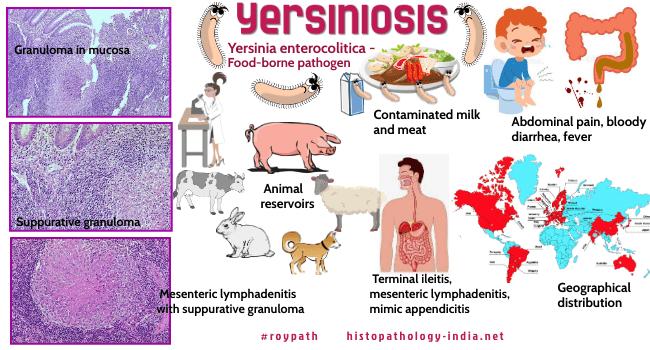|

Custom Search
|
|
Infectious Disease Online Pathology of Yersiniosis
|

| Yersiniosis refers to the
illnesses caused by Yersinia enterocolitica
and less often by Yersinia pseudotuberculosis
infections. It is self-limiting gastroenteritis, with severe invasive sicknesses like terminal ileitis, mesenteric lymphadenitis, mimicking appendicitis, and sometimes septicemia. Pigs are the major animal reservoir for the few strains of Yersinia enterocolitica that cause human illness, but rodents, rabbits, sheep, cattle, horses, dogs, and cats also can carry strains that cause human illness. |
Yersiniosis is caused by Yersinia enterocolitica and less often by Yersinia pseudotuberculosis.Note: Yersinia pestis causes human plague.Causative organism and mode of infection:Yersinia enterocolitica and Yersinia pseudotuberculosis are gram-negative, oval coccoid or rod-shape bacteria.Yersinia enterocolitica is an important food-borne pathogen.Both species are motile, facultative anaerobes found in the faeces of wild and domestic animals, including rodents, sheep, cattle, dogs, cats, and horses.Birds such as turkeys, ducks, geese, pigeons and canaries are common sources of Yersinia pseudotuberculosis.Both organisms have been isolated from drinking water and milk.Yersinia enterocolitica is more likely to be acquired from contaminated meat and Yersinia pseudotuberculosis from contact with infected animals.Using PCR, the detection rate of pathogenic Yersinia enterocolitica in raw pork products is high, which reinforces the assumption that these products are a transmission link between pigs and humans.Yersinia enterocolitica may be associated with the development of inflammatory bowel disease. Yersinia enterocolitica and Yersinia pseudotuberculosis have been implicated as causes of appendicitis, ileocolitis, and mesenteric adenitis. Symptoms: The symptoms of yersiniosis depend on the age of the person infected. Infection occurs most often in young children. Common symptoms in children are fever, abdominal pain, and diarrhea, which is often bloody. Symptoms typically develop 4 to 7 days after exposure and may last 1 to 3 weeks or longer. In older children and adults, right-sided abdominal pain and fever may be the predominant symptoms and may be confused with appendicitis. Complications are rare, and may include skin rash, joint pains, or spread of bacteria to the bloodstream. Pathology and pathogenesis: Ingested Yersinia enterocolitica proliferates in the ileum, invades the mucosa, produces ulcerations and necrosis of Peyer’s patches, and migrates by way of the lymphatics to the mesenteric lymph nodes. Arthralgia, arthritis, and erythema nodosum are complications. Septicemia is an uncommon complication but kills about one-half of those affected. Fever, diarrhea (sometimes bloody) and abdominal pain begin 4 to 10 days after penetration of the mucosa. Ingested Yersinia pseudotuberculosis penetrates the ileal mucosa, localizes in ileocaecal lymph nodes, and produces abscesses and granulomas in the lymph nodes, spleen, and liver. The granulomas may be centered in the lymphoid follicles. Diarrhea and abdominal pain in the right lower quadrant with fever may lead to an erroneous diagnosis of appendicitis. Diagnosis: Yersiniosis usually is diagnosed by detecting the bacteria in the stool of an infected person. Many laboratories do not routinely test for Yersinia, so it is important that the clinician notifies the laboratory when yersiniosis is suspected so that special tests can be done. No histologic features distinguish reliably between Yersinia species, or between Yersinia-positive and Yersinia-negative cases. Because special stains and cultures are often not diagnostic, PCR analysis is an excellent technique for the diagnosis of Yersinia.
Treatment: Streptomycin, gentamycin, tetracycline and trimethoprim-sulfamethoxazole are the antibiotics of choice.
|
|
|
Copyright © 2022 histopathology-india.net

